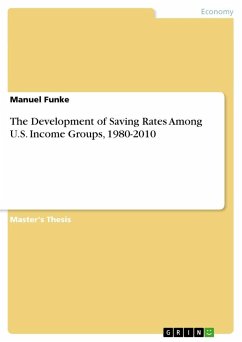Master's Thesis from the year 2012 in the subject Economics - Micro-economics, grade: 1,7, Free University of Berlin (John-F-Kennedy Institute), language: English, abstract: The U.S. household saving rate has dropped remarkably over the past three decades, falling from about 10 percent of disposable income in the early 1980s to near-zero values at the turn of the millennium. After decades of overall stable personal savings following the end of World War II, recently the household savings rate has reached a new all-time low after the Great Depression. However, the causes for this unprecedented decline in savings by American households remain a mystery. Numerous researchers have offered different explanations of the savings drop, including demographic changes, market growth and the rising proportion of capital gains, income and wealth inequality, governmental policies, and innovations in finance andcredit.However, regarding the studies done so far, it is to say that no consensus concerning the underlying reasons of the saving reduction is achieved at all. While scholars have analyzed the many different aspects of the savings drop, an agreement on the fundamental causes is still out of reach. The falling saving rate within the past 25 years of economic expansion is unique in history: while former patterns of household saving could be explained by severe political and macroeconomic changes, the recent substantial drop in times of economic prosperity seems more difficult to investigate.Comparable developments are hardly to be found in U.S. history as well as in other countries' statistics.Moreover, mainstream economic concepts and a major part of evidence suggest a positive correlation between income, wealth and saving. Hence, it seems striking that the decline in savings took place in a period of overall economic growth,where incomes and in particular the wealth-to-income has been growing. The purpose of this paper is to estimate how different income and wealth levels have been related to the household saving patterns within the last three decades in order to disentangle a further piece of the savings drop-puzzle. How was saving distributed across different income groups? How does growing income and wealth inequality relate to the distribution of savings and what is the actual impact of rising capital gains on saving patterns?








